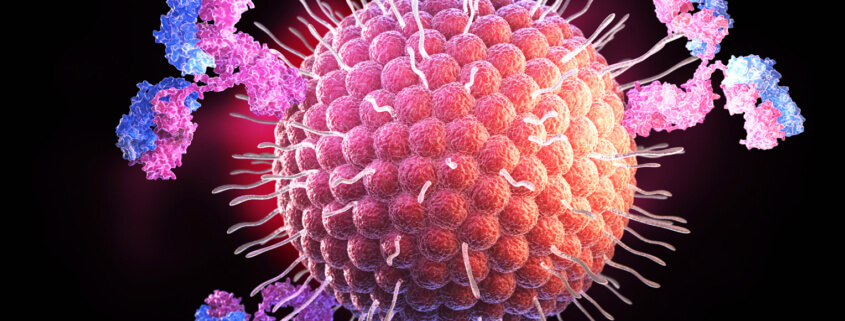By David Kilpatrick, PhD and Abbas Vafai, PhD
INTRODUCTION: Finding antigens which can be used for human Herpes virus (HHV) assays can be challenging. Many technical concerns need to be addressed, including how to express sufficient quantities of each antigen, and once produced, how the immune system responds to each antigen. In this paper, Brenner et. al, cloned and expressed 16 HHV antigens to be used in a fluorescence capture bead assay.
DISCUSSION: A series of the most immunogenic HHV antigens were selected, including 2 each for HSV-1 and -2, 3 for VZV, 5 for EBV, and 4 for CMV. The selected antigens were inserted into the pGEX4T3tag vector and expressed as Glutathione S-Transferase (GST) fusion proteins (GSTX-tag) using the last eleven amino acids of SV40 large T-antigen (tag). To test these expressed HHV antigens, reference sera from various sources were analyzed for antibodies against selected HHV antigens by species-specific monoplex (initial testing was done for each specific antigen) and Multiplex Serology (pooled antigens). HHV GST-tag fusion proteins were loaded onto glutathione case in-coated fluorescence-labeled polystyrene beads (COOH-beads xMAP Technology Microspheres, Luminex Corp. Austin, Texas, USA) by in situ affinity purification from the lysate. Up to 100 bead sets are distinguishable by the Luminex flow cytometer via different ratios of two
fluorescent dyes within the polystyrene microspheres. The performance characteristics (i.e. specificity, sensitivity and kappa statistics) for the Monoplex Serology assays for HHV 1–5 were compared to the gold-standard reference assays for each antigen. The reference sera were analyzed both in monoplex (i.e. one pathogen) and in multiplex (i.e. multiple pathogens) format to compare assay performance. The performance of HHV Multiplex Serology based on sensitivity and the overall statistical performance of the species-specific assays in Multiplex Serology
did not change. Sensitivity and specificity for overall seropositivity for all HHV species exceeded 90% in both monoplex and multiplex format. A high concordance with the corresponding reference assays was maintained (k ≥ 0.85). A direct comparison of Monoplex versus Multiplex Serology performance was conducted using ICCs and showed good to excellent reliability (ICC: 0.82–0.99).
CONCLUSION: Brenner et. al. stated they were successful in the development and validation of HHV Monoplex Serology assays against 5 out of 9 known human herpes viruses, namely HSV-1, HSV-2, VZV, EBV, and CMV. The species-specific Monoplex Serology assays were validated using reference sera analyzed with goldstandard reference assays. For each species-specific assay, only a small number of false-positives and falsenegatives was observed during validation. This resulted in a median specificity and sensitivity of 97.4% and 96.6%, respectively. The newly developed assays were found to be highly concordant with the established gold-standard reference assays (median kappa 0.93). While they were able to develop these bead-based fluorescence assay for
HHVs 1-5, they stated that antigens for species-specific Monoplex Serology assays were also developed for human herpes viruses HHV-6A & B, HHV-7, and KSHV. However, there are no universally applicable serological gold standard assays with sufficiently acceptable performance characteristics for clinical use available for these HHV species, so these assays could not be validated.
Nicole Brenner, Alexander J. Mentzer, Angelika Michel, Kristina Prager,
Johannes Brozy, Benedikt Weißbrich, Allison E. Aiello, Helen C. S. Meier, Judy
Breuer, Rachael Almond, Naomi Allen, Michael Pawlita, and Tim Waterboer.
2018. Validation of multiplex serology detecting human herpes viruses 1-5.
PLoS One. 2018; 13(12): e0209379.


